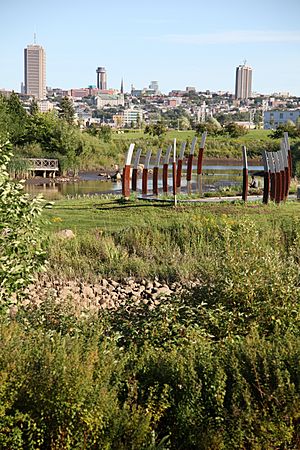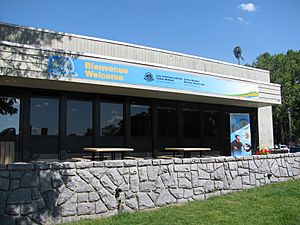Cartier-Brébeuf National Historic Site facts for kids
Quick facts for kids Cartier-Brébeuf National Historic Site |
|
|---|---|
 |
|
| Type | Urban park |
| Location | 175, rue de l'Espinay Quebec City, Quebec G1L 4W6 |
| Governing body | Parks Canada |
| Owner | Parks Canada |
| Designated | 1972 |
The Cartier-Brébeuf National Historic Site is a special place in Quebec City, Quebec, Canada. It's managed by Parks Canada. This site is important because it remembers two big moments in Canadian history.
First, it marks where French explorer Jacques Cartier and his crew spent a very tough winter in 1535-1536. They stayed near an Iroquoian village called Stadacona. Second, it remembers when the first Jesuit missionaries came to Quebec in 1625-1626.
The site is located where the Saint-Charles and Lairet rivers meet. Today, it's a 6.8-hectare park with an interpretation center. You can find many monuments and historical markers there. For a long time, before it became a park in 1972, the area was used for different businesses. These included a tannery, a pottery, and even a shipyard.
Now, the site offers museum exhibits and fun activities for school groups. It's also a great place to enjoy nature in the city. A bike path and a walking trail along the Saint-Charles River also run through the park.
Contents
Jacques Cartier's Winter Adventure (1535-1536)
During his second trip to Canada, Jacques Cartier was still hoping to find a way to Asia through the Saint Lawrence River. When he saw the river getting narrower near Quebec City, he looked for a safe harbor. He needed a place to leave his two biggest ships, the Grande Hermine and Petite Hermine. He planned to continue exploring on a smaller ship, the Émerillon, towards Hochelaga (which is now Montreal).
On September 8, 1535, Cartier found a good harbor. He named it Sainte-Croix (Holy Cross). It was right where the Saint-Charles and Lairet rivers meet, close to the Iroquoian village of Stadacona. When he returned from his trip, Cartier found that his crew had built a small fort around the ships. They were worried about the Stadaconeans.
Cartier and his crew decided to spend the winter there. They were not ready for the very cold Canadian winter. Instead of building warm shelters, they stayed inside their ships. This turned out to be a bad choice. The winter of 1535-1536 was very hard. Out of 110 men, 106 got scurvy, a terrible disease. Twenty-five of them died. Their bodies were likely buried at the site.
The other sailors were saved by a special tea called annedda. The Iroquoians knew how to make this tea from a Canadian tree, either white cedar or balsam fir. Before going back to France in the spring of 1536, Cartier put up a cross. It honored Francis I, the King of France. He wrote on it: "Long live Francis I by God's grace king of the France." Cartier had to leave the Petite Hermine behind because he didn't have enough sailors. He also took ten Iroquoians from Stadacona with him. It was five years before Cartier returned to Canada. In 1541, he chose a different spot, Cap-Rouge, to set up a new settlement called Charlesbourg-Royal.
Finding Proof of Cartier's Stay
Archaeologists have dug at the site many times. They hoped to find things left behind by Jacques Cartier's crew from 1535-1536. They also looked for traces of the Notre-Dame-des-Anges residence. These digs happened in 1959, 1962, 1986, 1993, 2004, and 2007.
Because many different activities took place on the land over hundreds of years, it's been hard to find direct proof of Cartier's stay. However, archaeologists have found many items from later times, like tools and pottery. The graves of the 25 sailors and the remains of the small fort are still waiting to be found.
So, the main proof of Cartier's visit comes from old writings. Both Jacques Cartier himself and Samuel de Champlain wrote about it.
Jacques Cartier wrote: "And we went some ten leagues up the river... We thought this river St-Charles a suitable place in which to lay up our ships in safety. We named it 'St-Croix', as we arrive there that day."
Samuel de Champlain wrote: "Moreover, near Quebec, there's little river... I am of opinion that this river (st-charles), which is North quarter North-West from our settlement, is a place where Jacques Cartier wintered, since there are still... remains of what seems to have been a chimney, the foundation of which has been found and indications of there having been ditches surrounding there dwelling which was small."
The Jesuits and Notre-Dame-des-Anges
The Cartier-Brébeuf site is also where a group of five Jesuit missionaries settled in 1625. Their goal was to teach the native people about their religion. This was the very first time the Society of Jesus (the Jesuits) set up a home in Quebec.
The group included Fathers Jean de Brébeuf, Énemond Massé, and Charles Lalement. There were also two brothers, François Chartoin and Gilbert Burel. They named their home Notre-Dame-des-Anges (Our Lady of the Angels). It had two buildings. The main one was made of wood planks, about 13 meters wide and 7.5 meters long. The second, smaller building was used as a barn, stable, and workshop.
The Jesuits had to leave in 1629 when the Kirke brothers took over Quebec City. They only came back in 1632. They found their buildings partly destroyed. In 1636, they rebuilt their home and made it bigger. It even hosted a seminary for Huron students until 1639.
How the Site Became a National Historic Site
People in Quebec City became more interested in remembering Jacques Cartier's second voyage in the 1800s. This led to the creation of the Cartier-Brébeuf National Historic Site. Here are some important steps in its history:
- 1835: A wooden cross was put up to remember Cartier's second voyage. It was in front of a hospital on the south side of the Saint-Charles River.
- 1886: The Quebec City Catholic Circle bought the land.
- 1888: The Catholic Circle put up a new metal cross to remember Cartier's 1535-1536 winter. This cross is still there today!
- 1920: The Cartier-Jesuits monument was officially opened.
- 1926: The cross was lit up.
- 1957: John Diefenbaker, who later became Prime Minister, visited the site. He then asked the Historic Sites and Monuments Board of Canada to recognize its importance.
- 1958: The site was officially recognized as historically important.
- 1959: The Canadian government bought the land. The first archaeological digs began.
- 1972: The site was built, a replica of the Grande Hermine ship was put in place, and the interpretation center opened.
- 1984: The cross was lit again and blessed by Pope John Paul II.
- 1985: The first longhouse was built. Sadly, it was destroyed by a fire that same year.
- 1986-1987: A second longhouse was built with a fence around it. The Grande Hermine replica was moved out of the water.
- October 11, 1987: Special stone markers (steles) were revealed. They honored the meeting of two cultures in the 16th century and Donnacona, an Iroquoian leader.
- 1996: A second plaque for Donnacona was unveiled in three languages.
- 2001: The Grande Hermine replica was taken down. A Jesuit display was put up.
- 2007: The longhouse was taken down to fix the Lairet River channel.
- 2008-2009: Big changes were made to make the site better and bring the Lairet River back into the open.
- 2010: The site fully reopened. Celebrations marked 475 years since Cartier's second voyage. New information panels were installed.
What You Can See at the Site Today
Things That Used to Be at the Site
From when the site opened in 1972 until 2001, a large replica of the Grande Hermine ship was on display. It was built in 1966 for a big event in Montreal in 1967. The replica was in an artificial lake until 1987. Then, it was moved out of the water, and its masts were taken off. It stayed out of the water until 2001. After 29 years, it was taken apart because it was becoming unsafe.
Two longhouses were also built at the site. These showed what the homes of the Saint-Lawrence Iroquoian people looked like. The first one was built in 1985 but was destroyed by a fire that same year. The second longhouse, which had a fence around it, was built in 1986-1987. It was taken down in 2007 to make way for new changes to the park.









